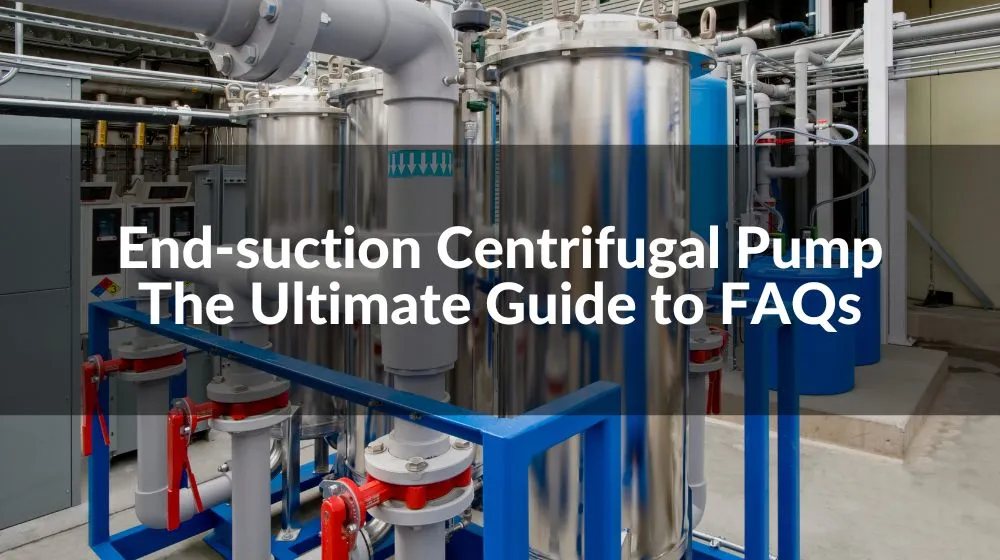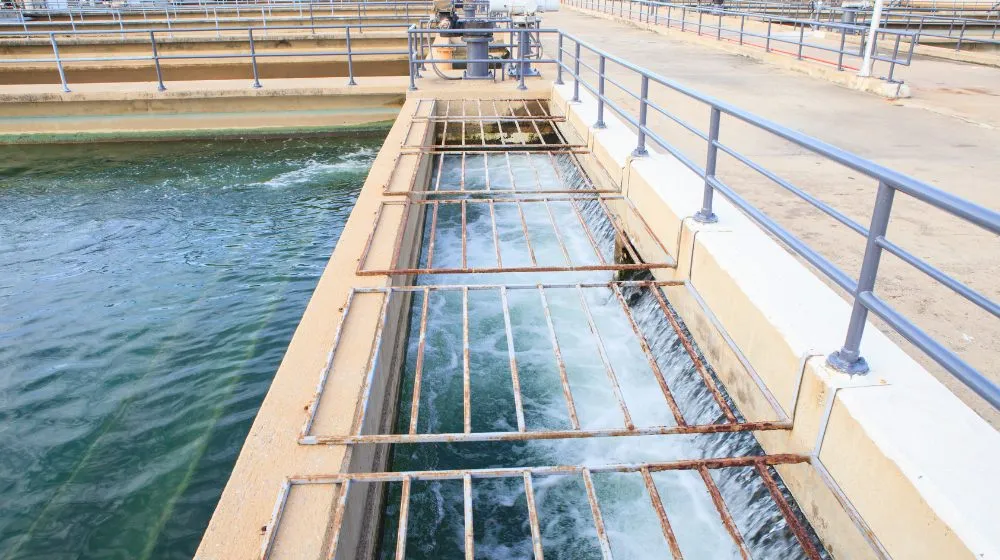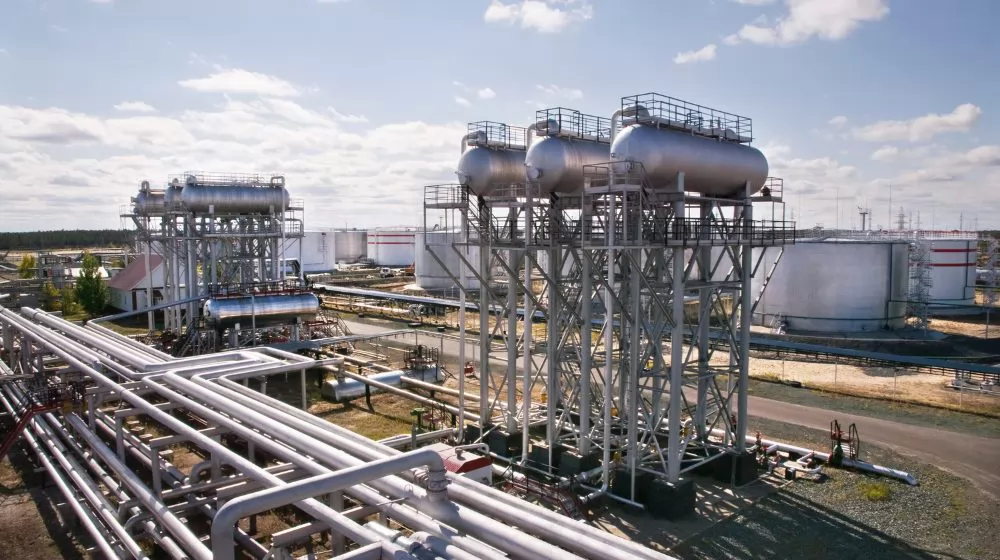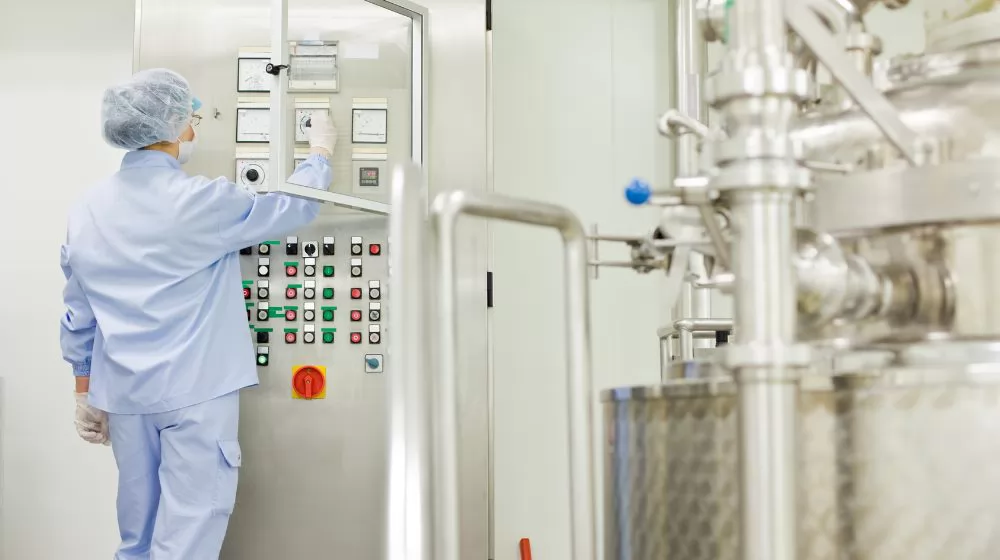


End-suction centrifugal pumps are an essential component in many industrial applications, providing reliable and efficient fluid transfer. As a crucial part of a system, choosing the right end-suction centrifugal pump is critical for optimizing performance and reducing maintenance costs. In this article, we will cover the key aspects of end-suction centrifugal pumps, including their advantages, applications, selection criteria, and maintenance.
What are the main differences between end suction pumps and other centrifugal pump types?
Key components and functions of end suction centrifugal pump
What are the advantages of using an end suction centrifugal pump?
How do I choose the right end suction centrifugal pump for my application?
How to Choose the Right End Suction Centrifugal Pump Manufacturer
What industry standards and regulations do end suction centrifugal pumps need to comply with?
An end-suction centrifugal pump is a type of pump that uses centrifugal force to transfer fluids. It is widely used in numerous industries for various applications, such as water supply, wastewater treatment, HVAC systems, and industrial processes. The pump's name, "end-suction," refers to the suction inlet located at the end of the pump casing.
End-suction centrifugal pumps consist of a rotating impeller, a volute casing, and an inlet and outlet connection. When the impeller rotates, it creates a centrifugal force that pushes the fluid towards the outer edges of the impeller. This action increases the fluid's velocity and generates a pressure difference, allowing the fluid to be discharged through the outlet connection.
End-suction centrifugal pumps play a vital role in numerous industries due to their reliability, efficiency, and versatility. They are extensively used for fluid transfer, circulation, and pressure boosting applications. Some of the key industries that heavily rely on end-suction centrifugal pumps include:
These pumps are essential for transporting water from sources such as rivers, lakes, or wells to treatment plants and distributing it to homes, businesses, and irrigation systems. They also play a crucial role in wastewater treatment processes, helping to transport and circulate wastewater for treatment and disposal.
End-suction centrifugal pumps are commonly used in heating, ventilation, and air conditioning (HVAC) systems to circulate chilled or hot water. They enable efficient temperature regulation in buildings, ensuring comfortable and controlled environments.
Many industrial processes require the transfer of fluids, such as chemicals, oils, or slurries. End-suction centrifugal pumps are widely used in industries such as manufacturing, petrochemicals, mining, and food processing to handle these fluids reliably and efficiently.
While there are various types of centrifugal pumps, including axial-flow pumps, mixed-flow pumps, and multi-stage pumps, the main difference lies in their design and application. The primary distinction between end-suction centrifugal pumps and other types is the location of the suction inlet.
In end-suction centrifugal pumps, the suction inlet is located at the end of the pump casing, perpendicular to the pump shaft. This design allows for easy installation and maintenance, as well as efficient fluid intake from a single direction.
On the other hand, other centrifugal pump types may have different suction inlet designs. For example, axial-flow pumps have an axial suction inlet, while mixed-flow pumps have a combination of axial and radial inlets. These designs are suitable for specific applications where a different flow pattern or higher efficiency is required.
Overall, the main advantage of end-suction centrifugal pumps lies in their simplicity, ease of installation, and wide range of applications. They offer reliable fluid transfer capabilities while providing cost-effective solutions for various industries.
End-suction centrifugal pumps consist of several key components, each playing a vital role in their operation:
The casing houses the impeller and directs the flow of fluid. It is designed to withstand the pressure generated by the pump and ensure efficient flow dynamics.
The impeller is a rotating component that imparts energy to the fluid, causing it to move in a specific direction. Impeller designs vary to accommodate different applications and fluid properties.
The pump's shaft connects the impeller to the motor, transmitting rotational energy. Bearings support the shaft and reduce friction, ensuring smooth operation and longevity.
Sealing elements prevent leakage between the pump's rotating and stationary parts. They play a crucial role in maintaining pump efficiency and preventing fluid loss.
The motor provides the necessary power to drive the pump. It can be electrically or mechanically coupled to the pump, depending on the application requirements.

End-suction centrifugal pumps offer a multitude of advantages that make them a preferred choice for fluid transfer and circulation in various industries. Let's explore some of the key benefits they provide:
End-suction centrifugal pumps are designed to deliver high flow rates and efficiently transfer fluids from one location to another. With their powerful impeller designs and optimized hydraulic pathways, these pumps can move substantial volumes of liquids with minimal energy consumption. This results in efficient operation and reduced operational costs over time.
One of the notable advantages of end-suction centrifugal pumps is their ease of installation and maintenance. Their compact design and standardized construction make them relatively simple to set up and integrate into existing systems. Additionally, accessing the pump components for routine maintenance or repairs is convenient, saving time and effort.
End-suction centrifugal pumps are highly versatile and capable of handling a wide range of fluids. Whether you need to pump clean water, corrosive chemicals, viscous oils, or abrasive slurries, these pumps can accommodate diverse liquid types. This flexibility makes them suitable for applications across industries such as water treatment, chemical processing, mining, and more.
End-suction centrifugal pumps are engineered to perform reliably under various operating conditions. They can handle different pressures, temperatures, and flow rates, allowing for adaptability in different environments and applications. Whether you require a pump for low-pressure systems or high-pressure industrial processes, end-suction centrifugal pumps can meet your needs.
Choosing an end-suction centrifugal pump can lead to cost savings in multiple ways. Their high efficiency ensures that less energy is consumed during operation, resulting in reduced energy expenses. Moreover, their simplified installation and maintenance requirements minimize downtime, maximizing productivity and reducing maintenance costs. The durability and longevity of these pumps also contribute to long-term cost-effectiveness.
End-suction centrifugal pumps are designed to work seamlessly with standard electric motors, simplifying the motor selection process. This compatibility allows for easy integration into existing systems or the option to choose from a wide range of readily available motors. It provides flexibility and convenience for users, ensuring a smooth and efficient pump-motor combination.
End-suction centrifugal pumps are renowned for their reliable performance. The precision engineering of their components, such as impellers and casings, ensures consistent flow rates and pressure delivery. This reliability is crucial for critical processes where consistent fluid transfer is essential for the overall system performance and productivity.
As end-suction centrifugal pumps are widely used and standardized across industries, the availability of spare parts is generally abundant. This availability translates into competitive pricing and reduced lead times when replacements or repairs are needed. It ensures that maintenance tasks can be carried out efficiently, minimizing downtime and optimizing operational continuity.
When considering end-suction centrifugal pumps, it's important to understand how they compare to other pump types. Let's explore the advantages and disadvantages of end-suction centrifugal pumps in comparison to alternative pump technologies:
End-suction centrifugal pumps are known for their simple design and compact size. Unlike some other pump types that may have complex configurations, end-suction pumps are relatively straightforward, making them easier to install, operate, and maintain.
Due to their simple construction, end-suction centrifugal pumps typically require less maintenance compared to more intricate pump designs. This translates to lower maintenance costs and reduced downtime, as routine maintenance tasks can be performed more efficiently.
End-suction centrifugal pumps are versatile and well-suited for various applications. They can handle a broad range of fluids, including liquids with solids or abrasive particles, making them suitable for industries such as water treatment, HVAC, chemical processing, and more.
End-suction centrifugal pumps often offer a cost-effective solution due to their simplicity and wide availability. They are typically less expensive to purchase, install, and maintain compared to more specialized pump types. Additionally, their energy efficiency can result in long-term cost savings.
End-suction centrifugal pumps are known for their high efficiency and reliable performance. They can achieve high flow rates and provide consistent pressure delivery, ensuring effective fluid transfer and circulation in various applications.
End-suction centrifugal pumps may have limitations in terms of the maximum head and pressure they can generate. In applications where high pressures or significant head heights are required, alternative pump types such as multistage centrifugal pumps or positive displacement pumps may be more suitable.
End-suction centrifugal pumps have specific Net Positive Suction Head (NPSH) requirements to prevent cavitation, which can cause damage to the pump and affect its performance. It's crucial to ensure that the system meets the NPSH criteria to avoid operational issues.
End-suction centrifugal pumps generally require a flooded suction or priming before operation. They may not have the inherent self-priming ability, meaning they can't draw fluid from a low level or lift it from a below-grade source without external assistance.
When handling highly viscous fluids, such as heavy oils or slurries, end-suction centrifugal pumps may experience reduced efficiency and require additional considerations. Other pump types, such as gear pumps or diaphragm pumps, may be more suitable for such applications.
End-suction centrifugal pumps may have limitations in terms of the temperature range they can handle. High-temperature fluids or extreme temperature differentials may require specialized pump types with enhanced materials and thermal capabilities.

Understanding the inner workings of an end-suction centrifugal pump is essential to grasp its functionality and operational principles. Let's delve into the process of how an end-suction centrifugal pump works:
At its core, an end-suction centrifugal pump utilizes centrifugal force to transfer fluids. The pump's main components, such as the impeller, casing, and volute, work together to generate the necessary flow and pressure. Here's a step-by-step breakdown of the pump's operation:
The process begins with the pump's suction inlet, which is connected to the fluid source or reservoir. The fluid enters the pump through the suction pipe due to the pressure difference created by the pump's impeller.
The heart of the end-suction centrifugal pump is its impeller—a rotating component consisting of curved blades or vanes. As the impeller spins, it imparts centrifugal force to the fluid, pushing it outward from the center of rotation.
The centrifugal force generated by the impeller causes the fluid to move radially outward from the impeller's eye or center. As the fluid moves away from the impeller, it gains kinetic energy and velocity.
The fluid then enters the volute casing—a spiral-shaped chamber surrounding the impeller. The volute casing gradually expands in size, which converts the kinetic energy of the fluid into pressure energy.
As the fluid moves through the expanding volute casing, its velocity decreases, while its pressure increases. This pressure increase is crucial for the fluid to overcome any system resistance or head height, allowing it to flow to the desired destination.
The fluid exits the pump through the discharge outlet located at the top of the pump casing. From there, it can be directed to the intended process, system, or distribution network.
In a continuous operation, the fluid that is discharged from the pump may need to be recirculated or redirected back into the system. This recirculation ensures a continuous flow of fluid and maintains the desired pressure or flow rate.
Throughout the process, the pump's impeller design, rotation speed, and pump characteristics play a crucial role in determining the flow rate, pressure, and overall performance. The impeller's geometry, such as the number of blades, their curvature, and the impeller diameter, influences the pump's efficiency and its ability to handle specific fluid properties.
It's worth noting that the end-suction centrifugal pump requires proper priming, meaning the pump and suction line must be filled with fluid before operation to ensure proper fluid intake. This priming process ensures that the pump has a continuous fluid supply and prevents issues such as cavitation.
The impeller is a critical component of an end-suction centrifugal pump that plays a vital role in determining its performance characteristics. The design of the impeller directly impacts the pump's efficiency, flow rate, pressure generation, and overall functionality. Let's explore the impeller design aspects and their effects on pump performance:
End-suction centrifugal pumps can employ different types of impellers, each with its unique characteristics and suitability for specific applications. The common impeller types include:
This impeller type consists of blades enclosed within a shroud or casing, ensuring a smooth flow path for the fluid. Closed impellers are known for their high efficiency and ability to handle solids and abrasive particles, making them suitable for applications such as wastewater treatment and handling slurries.
Semi-open impellers have blades that are partially enclosed by a shroud, leaving the other side exposed. This design allows the impeller to handle fluids with higher solids content without clogging, making it suitable for applications like mining and handling dirty water.
Open impellers have blades that are entirely exposed without a shroud. This design is advantageous for handling fluids with high viscosity or fluids containing fibers or stringy materials, as it reduces the risk of clogging. Open impellers are commonly used in applications such as pulp and paper manufacturing and wastewater treatment.
The impeller diameter significantly affects the pump's performance. Larger impeller diameters generally result in higher flow rates and lower head generation. On the other hand, smaller impeller diameters are associated with lower flow rates and higher head generation. The impeller diameter selection should be based on the desired flow rate and pressure requirements of the specific application.
The geometry of the impeller blades also plays a crucial role in pump performance. Some key aspects of impeller blade design include:
The number of blades on the impeller influences the pump's efficiency, stability, and hydraulic performance. A higher number of blades generally results in improved efficiency, reduced vibration, and better hydraulic performance, especially at lower flow rates. However, an excessive number of blades may lead to higher friction losses and reduced passage size, limiting the pump's handling of solids or viscous fluids.
The curvature and profile of the impeller blades determine the fluid flow pattern and energy transfer within the pump. The design of the blades affects factors such as flow velocity, pressure generation, and efficiency. Curved blades can enhance the pump's ability to handle solids, reduce turbulence, and improve efficiency by minimizing energy losses.
The material used to construct the impeller is critical, especially when handling corrosive or abrasive fluids. The impeller material should be compatible with the fluid being pumped to ensure durability and prevent premature wear. Common materials for impeller construction include stainless steel, cast iron, bronze, and various composite materials. The material selection should consider factors such as fluid properties, temperature, and chemical compatibility.
Impellers should be properly balanced to minimize vibration and ensure smooth operation. Unbalanced impellers can cause excessive wear, increased noise, and reduced overall performance. Additionally, trim impellers can be utilized to adjust the pump's performance characteristics by altering the impeller diameter or blade geometry.

The pump curve and its performance characteristics are essential for effectively analyzing and optimizing the operation of an end-suction centrifugal pump. By understanding the pump curve, you can gain valuable insights into its flow rate, head, efficiency, and power consumption. Let's explore in detail the pump curve and the key performance characteristics associated with it:
The pump curve provides a graphical representation of the pump's performance characteristics. It illustrates the relationship between the flow rate (Q) and the head (H) that the pump can deliver at various operating points. Typically, the pump curve is presented as a plot with the flow rate on the x-axis and the head on the y-axis.
The pump curve consists of three primary curves that depict different aspects of the pump's performance:
The head curve showcases the pump's capability to generate head (pressure) at different flow rates. It demonstrates the maximum head that the pump can achieve under varying operating conditions. As the flow rate increases, the head generated by the pump typically decreases due to hydraulic losses within the pump and the system.
The flow curve represents the relationship between the pump's flow rate and the head it can deliver. It indicates the flow rate that the pump can provide at a specific head. As the head increases, the flow rate generally decreases due to the resistance encountered in the system.
The efficiency curve displays the pump's efficiency at different operating points. It reveals the efficiency percentage at which the pump converts the input power into hydraulic power. The highest point on the efficiency curve is often referred to as the "Best Efficiency Point" (BEP).
The pump curve also incorporates information related to Net Positive Suction Head (NPSH) and cavitation, which are crucial considerations:
This parameter specifies the minimum NPSH value required by the pump to operate without experiencing cavitation. It is typically provided by the pump manufacturer and must be compared to the available NPSH in the system to ensure trouble-free operation.
The pump curve may indicate a cavitation region where the pump is susceptible to cavitation if operated at specific flow rates and heads. Operating the pump within this region should be avoided to prevent damage and performance degradation.
Analyzing the pump curve enables the selection of the optimal operating point that aligns with the desired flow rate and head for a specific application. Several factors should be considered when choosing the operating point:
Determine the required flow rate and head for the system, considering factors such as pressure drop, elevation changes, and desired performance.
Select an operating point close to the pump's highest efficiency on the efficiency curve. This ensures efficient energy usage and cost-effectiveness.
Ensure that the available NPSH in the system exceeds the NPSH required (NPSHr) specified on the pump curve to prevent cavitation.
The pump curve also provides insights into the power consumption of the pump at different operating points. By multiplying the flow rate (Q) by the head (H) and dividing it by the overall efficiency of the pump, you can estimate the power consumption. This calculation helps in understanding the power requirements and optimizing energy usage.
To effectively interpret the pump curve, follow these guidelines:
Determine the required flow rate and head for your application.
Locate the intersection point on the pump curve that corresponds to the desired flow rate and head.
Check the efficiency curve to ensure that the selected operating point is close to the pump's highest efficiency (BEP). This helps maximize energy efficiency and minimize operating costs.
Verify that the available NPSH in the system exceeds the NPSH required (NPSHr) indicated on the pump curve to avoid cavitation.
Calculate the power consumption by multiplying the flow rate (Q) by the head (H) and dividing it by the overall efficiency of the pump.
Evaluate the pump curve to understand the pump's performance characteristics across different operating conditions.
By thoroughly analyzing the pump curve, you can make informed decisions regarding the optimal operating point, energy efficiency, and performance of the end-suction centrifugal pump.
It's important to note that pump curves are specific to each pump model and size. When selecting or evaluating a pump, refer to the manufacturer's pump curve data for accurate and reliable information.
Selecting the right end suction centrifugal pump for your specific application is crucial to ensure optimal performance, reliability, and efficiency. Considering the numerous factors involved in the selection process, it's important to carefully evaluate the requirements of your system. Here are some key considerations to help you make an informed decision:
Determine the desired flow rate for your application. Consider factors such as the volume of fluid to be moved and any variations in flow rate that may occur.
Evaluate the total head or pressure needed to overcome the system resistance and achieve the desired fluid flow. Account for factors such as elevation changes, pipe friction, and any additional head requirements.
Consider the compatibility of the pump materials with the fluid being handled. Ensure that the pump components, such as impellers and casings, are constructed from materials that can withstand the characteristics of the fluid, including its corrosiveness, temperature, and viscosity.
Assess the efficiency of the pump at different operating points. Select a pump that operates close to its highest efficiency point to maximize energy efficiency and minimize operating costs.
Determine the available Net Positive Suction Head (NPSH) in your system. Ensure that it exceeds the NPSH required (NPSHr) specified by the pump manufacturer to avoid cavitation.
Consider the reliability and durability of the pump. Look for reputable manufacturers known for producing high-quality pumps with a track record of performance and reliability.
Evaluate the maintenance requirements of the pump. Choose a pump that is easy to maintain and service, with readily available spare parts.
Assess your budgetary constraints and select a pump that offers the best balance between cost and performance. Avoid compromising on quality and reliability for a lower price.
To select the right end suction centrifugal pump, it's important to have a clear understanding of your flow, head, and system requirements. Consider the following steps:
Determine the required flow rate and head based on your application's specifications and the fluid's characteristics.
Plot the flow rate and head requirements on a system curve to visualize the pump's operating point. The system curve represents the relationship between flow rate and head, incorporating the resistance of the system.
Choose a pump whose performance curve intersects the system curve at or near the desired operating point. This ensures that the pump can deliver the required flow rate at the specified head.
When selecting a pump, consider the compatibility of its materials with the fluid being pumped. Different fluids may require specific materials to avoid corrosion, erosion, or other forms of damage. Consult with the pump manufacturer or a technical expert to select the appropriate materials for your application.

Selecting a suitable end suction centrifugal pump manufacturer is a critical step in ensuring the quality, reliability, and performance of your pump. With numerous manufacturers available, it's essential to carefully evaluate your options and make an informed decision. Here are some key considerations to help you choose the right manufacturer:
Look for manufacturers with a solid reputation and extensive experience in designing and producing end suction centrifugal pumps. A manufacturer with a long-standing presence in the industry is more likely to have the expertise and knowledge required to deliver high-quality pumps.
Consider the manufacturer's product range and whether they offer a variety of pump models and sizes. A manufacturer with a diverse product range gives you more options to find a pump that precisely meets your application requirements. Additionally, inquire about their customization capabilities to accommodate any unique specifications you may have.
Ensure that the manufacturer is committed to producing pumps of the highest quality and reliability. Look for certifications, such as ISO 9001, that indicate adherence to rigorous quality standards. Additionally, check if the manufacturer conducts rigorous testing and inspection processes to guarantee the performance and durability of their pumps.
Consider the level of technical support and after-sales service provided by the manufacturer. A reputable manufacturer should offer prompt assistance, troubleshooting guidance, and readily available spare parts. Efficient technical support and service ensure that any issues or concerns are addressed promptly, minimizing downtime and maximizing the lifespan of your pump.
Verify that the manufacturer complies with relevant industry standards and regulations. End suction centrifugal pumps should meet recognized standards for performance, safety, and efficiency. Look for certifications like CE (Conformité Européene) or ANSI (American National Standards Institute) to ensure the manufacturer's adherence to these standards.
Research customer reviews and feedback to gauge the manufacturer's reputation and customer satisfaction. Look for testimonials or case studies from other customers who have worked with the manufacturer. Positive reviews and testimonials can provide valuable insights into the manufacturer's product quality, customer service, and overall reliability.
Consider the price and value offered by the manufacturer. While price is an important factor, it should not be the sole determinant of your decision. Evaluate the overall value of the pump, including its quality, performance, reliability, and after-sales support. Choosing a pump solely based on price may lead to compromises in terms of quality and long-term performance.
Take the time to thoroughly research and compare different manufacturers. Visit their websites, review product catalogs, and gather information on their manufacturing processes, certifications, and customer support. Request quotes and compare pricing, warranty terms, and delivery timelines. This research phase will provide you with a comprehensive understanding of each manufacturer's capabilities and help you make an informed decision.
Proper installation and commissioning are crucial to ensure the optimal performance and longevity of your end suction centrifugal pump. Following the recommended procedures and guidelines provided by the manufacturer will help you achieve reliable and efficient operation. Here are the key steps to consider during the installation and commissioning process:
Before installing the pump, it's important to make necessary preparations and take precautions to ensure a smooth and trouble-free installation:
Accurate alignment of the pump with the driver (e.g., motor) is critical to minimize vibration, reduce wear, and ensure efficient operation. Follow these steps for proper alignment:
Make proper electrical connections following the manufacturer's instructions and local electrical codes:
For end suction centrifugal pumps, priming and venting are essential to remove any air or gases from the pump and suction line:
After installation, it is necessary to perform debugging and performance testing to ensure that the pump operates as expected:
Fine-tuning the pump's performance may be necessary to optimize its efficiency and achieve the desired operating conditions:
Maintain thorough documentation and records throughout the installation and commissioning process:

Regular maintenance and timely troubleshooting are essential to ensure the optimal performance, longevity, and reliability of your end suction centrifugal pump. By implementing proper maintenance practices and addressing issues promptly, you can minimize downtime and maximize the efficiency of your pump. Here are some key aspects to consider for maintenance and troubleshooting:
Implementing a regular maintenance schedule will help keep your pump in optimal condition. Consider the following tasks:
Regularly inspect the pump components, such as the impeller, casing, seals, and bearings, for any signs of wear, corrosion, or damage. Clean these components as necessary to prevent debris buildup and ensure smooth operation.
Follow the manufacturer's recommendations for lubrication intervals and procedures. Proper lubrication of bearings and other moving parts reduces friction, extends component life, and enhances efficiency.
If your pump is belt-driven, regularly check and adjust the belt tension according to the manufacturer's guidelines. Proper tension ensures efficient power transmission and prevents slippage.
Periodically measure vibration levels and temperature readings of the pump and motor. Sudden changes or abnormal readings may indicate underlying issues and should be investigated further.
Become familiar with common pump issues and their troubleshooting solutions. Here are some frequently asked questions and troubleshooting tips:
Q: Why is the pump not priming?
A: Check for air leaks in the suction line or a clogged suction strainer. Ensure that the pump is properly primed and the vent valve is closed.
Q: What should I do if the pump is overheating?
A: Inspect the cooling system, such as the impeller and volute, for blockages or restrictions. Verify that the motor is operating within its temperature limits. Consider increasing the cooling capacity if necessary.
Q: Why is the pump experiencing reduced flow rate or head?
A: Check for obstructions or blockages in the suction or discharge lines. Examine the impeller for wear or damage. Adjust the impeller diameter or motor speed to achieve the desired performance.
Q: How can I prevent cavitation?
A: Ensure that the Net Positive Suction Head (NPSH) available exceeds the pump's required NPSH. Increase the suction pipe diameter, reduce suction pipe length, or lower the pump's operating speed to minimize the risk of cavitation.
In the event of pump failure or performance deviations, conduct a thorough failure analysis to identify the root causes. Take the following steps:
Determine whether the failure is related to mechanical, hydraulic, electrical, or other factors. This will help narrow down the potential causes.
Examine the affected components, operating conditions, and maintenance history. Consider factors such as excessive vibration, incorrect installation, inadequate lubrication, or chemical incompatibility.
Based on the failure analysis, take appropriate preventive measures to mitigate future issues. This may involve upgrading components, adjusting operating parameters, improving maintenance practices, or implementing additional safety measures.
End suction centrifugal pumps find wide application across various industries due to their versatility, efficiency, and reliability. Their robust design and ability to handle different fluids make them indispensable in numerous sectors. Let's explore some of the key applications and industries where end suction centrifugal pumps play a vital role:
End suction centrifugal pumps are extensively used in water supply systems and wastewater treatment plants. Their ability to handle large volumes of water efficiently makes them ideal for:
End suction centrifugal pumps are widely employed in heating, ventilation, and air conditioning (HVAC) systems, as well as for irrigation and various industrial processes, including:
In the oil and gas industry, end suction centrifugal pumps are utilized in a range of applications, such as:
The chemical and pharmaceutical industry relies on end suction centrifugal pumps for various tasks, including:
In the mining and construction sectors, end suction centrifugal pumps are utilized for applications like:
End suction centrifugal pumps play a crucial role in the food and beverage industry, where hygiene and product integrity are paramount. They are used for:
End suction centrifugal pumps find application in power plants for various tasks, such as:
End-suction centrifugal pumps are subject to various industry standards and regulations to ensure their safety, reliability, and compliance with specific application requirements. These standards and regulations outline guidelines for design, performance, and materials used in pump construction. Let's explore some of the key industry standards and regulations that end-suction centrifugal pumps need to comply with:
ISO 5199 is an international standard that specifically addresses the design and performance requirements for end-suction centrifugal pumps used in the chemical process industries. It covers aspects such as dimensions, materials, mechanical design, and performance testing methods. Compliance with ISO 5199 ensures the pump's reliability and interchangeability of parts.
API 610 is a widely recognized standard developed by the American Petroleum Institute (API) for centrifugal pumps used in the petroleum, petrochemical, and natural gas industries. It sets requirements for pump design, materials, performance, and testing. Compliance with API 610 ensures the pump's suitability for critical applications in the oil and gas sector.
The American National Standards Institute (ANSI) and the Hydraulic Institute (HI) have jointly developed ANSI/HI 1.6, which provides guidelines for end-suction centrifugal pumps used in general-purpose industrial applications. It covers various aspects, including design, materials, testing, and performance. Compliance with ANSI/HI 1.6 ensures reliable and efficient pump operation in a wide range of industrial settings.
ASME B73.1 is a standard published by the American Society of Mechanical Engineers (ASME) that focuses on the requirements for horizontal end-suction centrifugal pumps used in chemical process industries. It specifies design criteria, materials, testing, and performance parameters. Compliance with ASME B73.1 ensures the pump's reliability and compatibility with chemical handling applications.
While not specific to pump design, the National Electrical Code (NEC) establishes electrical safety requirements for pumps and their associated electrical systems. It covers aspects such as wiring, grounding, motor protection, and explosion-proof classifications. Compliance with NEC ensures safe electrical operation and minimizes the risk of electrical hazards.
End-suction centrifugal pumps may need to comply with energy efficiency standards and regulations, such as the European Union's Ecodesign Directive (ErP Directive) or the U.S. Department of Energy's (DOE) regulations. These standards aim to promote energy efficiency and reduce environmental impact by setting minimum efficiency levels for pumps. Compliance with energy efficiency standards helps optimize energy consumption and operating costs.
Ensuring the safety of personnel and equipment is of utmost importance when operating and maintaining end-suction centrifugal pumps. These pumps involve rotating machinery and handle potentially hazardous fluids, making it essential to follow safety precautions. Let's explore some key safety measures to consider during the operation and maintenance of end-suction centrifugal pumps:
Before starting any work, ensure that personnel are trained in pump operation, maintenance, and safety procedures. Proper training reduces the risk of accidents and improves overall safety.
Wear appropriate personal protective equipment (PPE), including safety goggles, gloves, hearing protection, and safety shoes, when working with pumps or handling fluids.
Follow lockout/tagout procedures to isolate the pump from power sources before performing maintenance or repair tasks.
Keep a safe distance from rotating parts and ensure long hair, loose clothing, and jewelry are secured to avoid entanglement hazards.
Be cautious of hot surfaces, high-pressure lines, and potential electrical hazards in pump installations.
Ensure adequate ventilation in pump rooms or areas where pumps are located to prevent the accumulation of hazardous gases or vapors.
Follow proper procedures for handling and storing hazardous fluids, including adherence to Material Safety Data Sheets (MSDS) and local regulations.
Use appropriate containment measures, such as spill kits or secondary containment, to prevent the release of hazardous materials in case of leaks or spills.
Ensure that electrical connections and components are properly grounded and comply with applicable electrical codes and standards.
Regularly inspect electrical wiring, connections, and motor controls for any signs of wear, damage, or overheating. Replace or repair faulty components promptly.
Follow proper procedures for working on electrical systems, including de-energizing circuits, using lockout/tagout procedures, and employing proper insulation and tools.
Install pressure relief valves or devices in the system to prevent overpressurization and potential damage to the pump or associated components.
Regularly inspect and test pressure relief valves to ensure they are functioning properly and set to the correct pressure limits.
Before performing maintenance tasks that involve system pressure, ensure proper isolation and depressurization of the system to prevent accidental releases or sudden pressure surges.
Follow the manufacturer's recommended maintenance procedures and schedules for the pump and associated components.
Perform regular inspections of pump components, including seals, bearings, impellers, and couplings, to identify any signs of wear, corrosion, or damage. Replace or repair damaged parts promptly.
Use appropriate tools and techniques when disassembling or assembling pump components to prevent injuries and ensure proper reassembly.
Ensure that the pump is properly aligned and mounted to its foundation to prevent excessive vibration, which can lead to premature failures.
Have a well-defined emergency response plan in place, including procedures for handling spills, leaks, pump failures, and personnel injuries.
Train personnel on emergency response procedures and make sure they are aware of the location and proper use of emergency equipment, such as fire extinguishers and first aid kits.
Regularly conduct drills and exercises to practice emergency scenarios and evaluate the effectiveness of the response plan.
In conclusion, end-suction centrifugal pumps offer exceptional performance and versatility across various industries. Their advantages, such as simple design, ease of maintenance, and high efficiency, make them a popular choice for fluid handling applications. When it comes to selecting a reliable and reputable pump manufacturer, look no further than Shanghai Liancheng. As a leading centrifugal pump manufacturer, Shanghai Liancheng is committed to delivering high-quality pumps that meet your specific requirements. Visit our website at https://www.liancheng-pump.com/uploads//uploads// to explore our range of products and experience the reliability and excellence that sets us apart.
Read More:
Top 10 Centrifugal Pump Manufacturer 2023
Centrifugal Water Pumps: Everything You Need to Know
.png)

